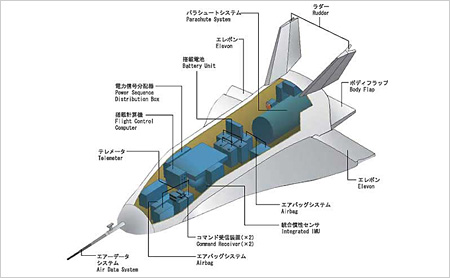Press Release
index-
- July 1, 2003 (18:35)
- Results of the First Flight Experiment of High Speed Flight Demonstration Phase II
-
- November 16, 2002 (08:30)
- Results of the Third Flight Experiment of High Speed Flight Demonstration Phase I
About High Speed Flight Demonstration "HSFD"
 |
A means of safe transportation is necessary in order to make it possible for everybody to easily go to space. The former National Space Development Agency of Japan (NASDA) and the former National Aerospace Laboratory (NAL) proposed a reusable space transportation system for realizing this dream by ensuring its safety through implementation of sufficient tests and demonstrations. As part of a series of these tests and demonstrations, the High Speed Flight Demonstration project (HSFD) was conducted. |
|---|
Flight Experiment
Phase I
Phase I was conducted at Aeon Field on Christmas Island. Upon receiving a command, the vehicle automatically took off, flied up to reach an altitude of approximately five kms, and made an automatic landing. The flight profile could be set up freely by changing the flight program data. This flexibility enabled us to verify communication functions between the vehicle and the landing facility and to perform various technical demonstrations including verification of the navigation function.
Major components of the Vehicle #1The vehicle for the Phase I (vehicle #1) is a 25% similar model of the H-II Orbiting Plane-Experimental (HOPE-X), an unmanned re-entry vehicle. Taking off and landing on a runway, the vehicle is equipped with a jet engine and landing gears (to be retracted into the fuselage). The vehicle has Flight Control Computer, which determines the flight direction and attitude and controls various on-board equipments, integrated IMU (Inertial Measurement Unit) with D-GPS, telemeters and command receivers for radio communications with the ground stations. Major Characteristics of the vehicle #1
|
Phase II
In Phase II, the test vehicle was lifted by a stratospheric balloon and released from it at an altitude of about 20 to 30km. The vehicle was then accelerated in free fall up to transonic speeds and kept at a specific Mach speed for the data acquisition phase to acquire various aerodynamic data. After data acquisition, the speed was reduced as the vehicle raised its body. The vehicle was gliding over its target recovery area at an altitude of approximately 1.5 km a few minutes after the release to open parachutes for final slowdown. After making the vehicle's attitude horizontal, the airbag under the vehicle was inflated to land.
The major characteristic of this experiment was autonomous flight between its release from the balloon and landing without any control from the ground.
The experiment was performed in cooperation with CNES (Centre National d'Etudes Spatials, the French Space Agency.) CNES was in charge of the development, operation and post-landing recovery of the balloon, and weather observations for the experiment.
Major components of the Vehicle #2The vehicle for the Phase II(vehicle #2) is a 25% completed scaled model of the HOPE-X. The devices on the surface such as antennas are designed not to affect aerodynamic characteristics of the vehicle. The vehicle #2 has generally the same components as those of the vehicle #1 except the jet engine and the landing gears. In this vehicle, the jet engine is replaced by a parachute system to recover the vehicle, and the wheels by airbags to absorb a shock at touch down. In addition, about 30 pressure sensors are installed on the surface of the fuselage and the base plane to acquire aerodynamic data during the flight at a transonic speed. Major Characteristics of the vehicle #2
|
 Large Image
Large Image Large Image
Large Image